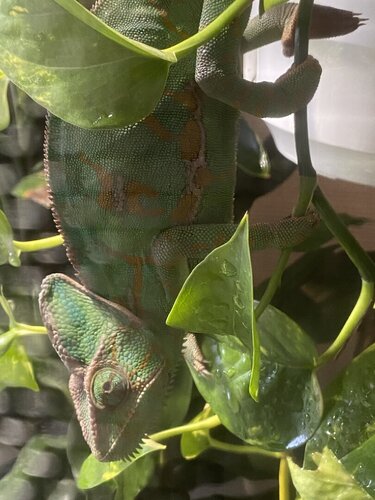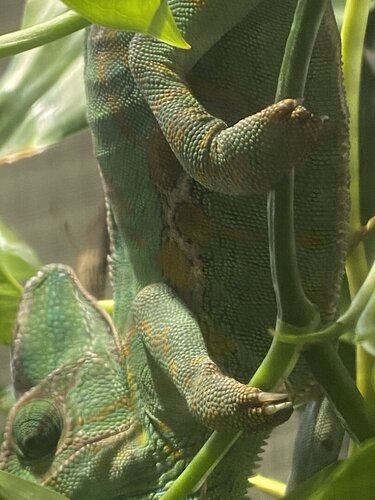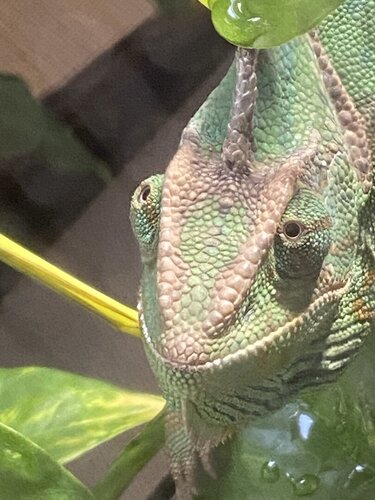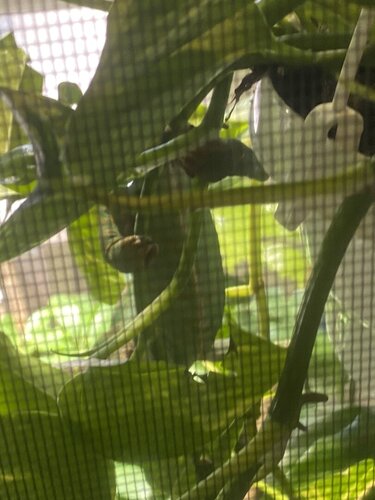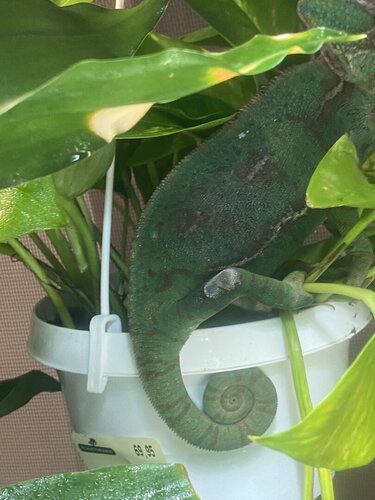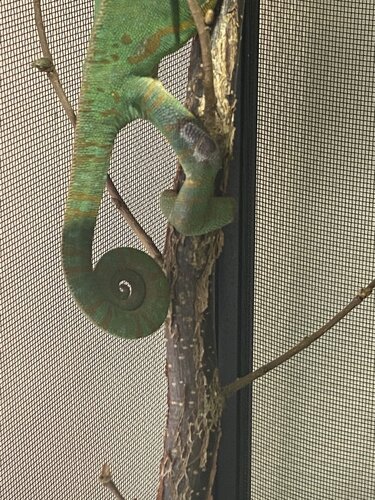malle000999
Member
Hey, so I have never owned a chameleon before and I wanted to check if everything is okay. So does my Cham look normal or is there something that doesn’t look right?
like is she dehydrated or something
She has a thermal burn that I’m currently working on healing.
* Your Chameleon - The species, sex, and age of your chameleon. How long has it been in your care?
- veiled chameleon
- female
- in my care 3 months
- age 7 months
* Handling - How often do you handle your chameleon?
- I haven’t Handel her only hand feed
* Feeding - What are you feeding your cham? What amount? What is the schedule? How are you gut-loading your feeders?
- grasshoppers about 5-6 every other day
-I feed my feeders weeds from my yard or oats or cucumber
* Supplements - What brand and type of calcium and vitamin products are you dusting
your feeders with and what is the schedule?
-calsium and d3 2 times a week
-with nekton
* Watering - What kind of watering technique do you use? How often and how long to you mist? Do you see your chameleon drinking?
- yes I see her drinking, sometimes
- I have a dripper and it’s always on except at night
-I mist about 2 minutes 3-5 times a day
* Fecal Description - Briefly note colors and consistency from recent droppings. Has this chameleon ever been tested for parasites?
- I don’t know if she has been tested the seller did not tell me
-she is normally dark green, but right know she is turquoise
-her poop is fine with the little yellow/white thing
* History - Any previous information about your cham that might be useful to others when trying to help you.
- she laid eggs 1 month ago
Cage Info:
* Cage Type - Describe your cage (Glass, Screen, Combo?) What are the dimensions?
-screen cage 61 cm 61 cm 122cm
* Lighting - What brand, model, and types of lighting are you using? What is your daily lighting schedule?
-HID with a uv-b light
* Temperature - What temp range have you created (cage floor to basking spot)? Lowest overnight temp? How do you measure these temps?
-a spot with 30° and the bottom 22° and the rest is 25°
* Humidity - What are your humidity levels? How are you creating and maintaining these levels? What do you use to measure humidity?
- I don’t know the humidity
* Plants - Are you using live plants? If so, what kind?
- I use live plants all chameleon safe
* Placement - Where is your cage located? Is it near any fans, air vents, or high traffic areas? At what height is the top of the cage relative to your room floor?
-located in my room by my door next to a window
- about 50 cm from the roof
* Location - Where are you geographically located?
-location is in Denmark
Current Problem - The current problem you are concerned about.
- if she looks normal
like is she dehydrated or something
She has a thermal burn that I’m currently working on healing.
* Your Chameleon - The species, sex, and age of your chameleon. How long has it been in your care?
- veiled chameleon
- female
- in my care 3 months
- age 7 months
* Handling - How often do you handle your chameleon?
- I haven’t Handel her only hand feed
* Feeding - What are you feeding your cham? What amount? What is the schedule? How are you gut-loading your feeders?
- grasshoppers about 5-6 every other day
-I feed my feeders weeds from my yard or oats or cucumber
* Supplements - What brand and type of calcium and vitamin products are you dusting
your feeders with and what is the schedule?
-calsium and d3 2 times a week
-with nekton
* Watering - What kind of watering technique do you use? How often and how long to you mist? Do you see your chameleon drinking?
- yes I see her drinking, sometimes
- I have a dripper and it’s always on except at night
-I mist about 2 minutes 3-5 times a day
* Fecal Description - Briefly note colors and consistency from recent droppings. Has this chameleon ever been tested for parasites?
- I don’t know if she has been tested the seller did not tell me
-she is normally dark green, but right know she is turquoise
-her poop is fine with the little yellow/white thing
* History - Any previous information about your cham that might be useful to others when trying to help you.
- she laid eggs 1 month ago
Cage Info:
* Cage Type - Describe your cage (Glass, Screen, Combo?) What are the dimensions?
-screen cage 61 cm 61 cm 122cm
* Lighting - What brand, model, and types of lighting are you using? What is your daily lighting schedule?
-HID with a uv-b light
* Temperature - What temp range have you created (cage floor to basking spot)? Lowest overnight temp? How do you measure these temps?
-a spot with 30° and the bottom 22° and the rest is 25°
* Humidity - What are your humidity levels? How are you creating and maintaining these levels? What do you use to measure humidity?
- I don’t know the humidity
* Plants - Are you using live plants? If so, what kind?
- I use live plants all chameleon safe
* Placement - Where is your cage located? Is it near any fans, air vents, or high traffic areas? At what height is the top of the cage relative to your room floor?
-located in my room by my door next to a window
- about 50 cm from the roof
* Location - Where are you geographically located?
-location is in Denmark
Current Problem - The current problem you are concerned about.
- if she looks normal

